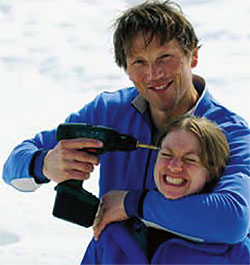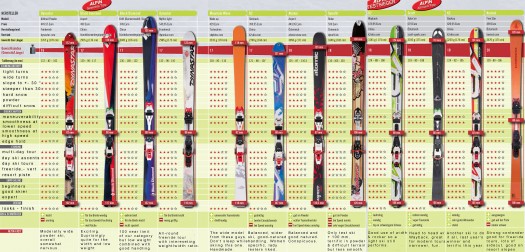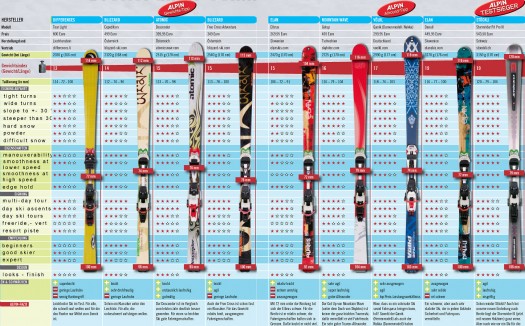
Alpin ski review editor Olaf and a lucky tester. The German caption translates to something like 'If a screw is loose, we fix it immediately.' Indeed.
Introduction from WildSnow Editors: Today marks the debut of our translated gear reviews from Alpin magazine. Through our attendance at press events in Europe, we’ve come to know Alpin category editor Olaf Perwitzschky, and worked things out with him to publish translated versions of Alpin ski reviews. We like the Alpin reviews because they’re based on serious ski testing by a group of incredibly skilled backcountry skiers — and they have the guts to pick clear winners. Plus, just as we usually do here at WildSnow, Alpin filters their reviews so they include only the products that test well.
Many of you have asked if we’d be willing to organize and publish our own ski reviews. We of course publish our ‘takes,” but doing an overall yearly review would be redundant with other publications doing so as well. That being the case, we’re still not big fans of the way most North American ski reviews are presented. They lack detail, and sometimes seem too bro brah (or pro brah?) to take seriously. I mean, do we really care how great the after party was? Knowing Olaf and the Euro way with this sort of stuff, we are here to say we take what Alpin is doing seriously, and are honored to do the English branch of publication.

Alpin magazine backcountry skiing test chart for their 'wide' category of skis at 80+ mm waist, but not so wide they'd be inappropriate for human powered vert. Our translations were done by Wildsnow editors using Google and are paraphrases rather than literal. For untranslated words just use any online translator, as the gist is easy to get. Interesting to me how much the Alpin testers liked the K2 and BD offerings -- and we are bummed about the excellent skis Hagan, Dynafit and Trab declined to include. I hope the kids in the playpen can get past that next year -- consolation is that with so many great skis out there, sour grape action on the part of a company won't really mess up your shopping. Take our word for it, you can pick out of the included Alpin recommendations and be as happy as if you'd looked elsewhere. Know that 'Testsieger' is the test winner, 'gewichts tipp' is the weight-performance winner. (Please also see the sub-80mm chart below). CLICK IMAGE TO ENLARGE.
WildSnow.com Editor’s intro continued:
Probably to Alpin’s credit (as they’re fairly hard hitting and pick clear winners) some companies have chosen not to provide skis for Alpin’s test due to their take on how Alpin has evaluated their skis in the past. Sadly, Dynafit, Fischer, Trab and Hagan all are in that category. (Alpin did obtain a pair of Dynafit Stoke on the open market for their test). We have quite a bit of experience with Dynafit and could easily plug their skis into this review (we’d of course rate Manaslu as a specialized powder board with less than average edge hold, while we’d rate Seven Summits as an excellent all-rounder. Sorry to say we don’t have enough depth of experience with current Fischer, Hagan and Trab to rate any of their models.) Main thing to know with this is with so many excellent skis out there, what Alpin DID include in their test report is an excellent selection, and from what we know about the overall market, anyone would be perfectly happy simply shopping off the Alpin charts despite some brands not being represented.
We find it rather childish for companies to pull product or advertising when they don’t like what someone says about their stuff. It is axiomatic in marketing that the first step to success is to get people talking about your product. More, if you’re confident in your product, you’ll keep providing it for testing while realizing any REAL ski test is a zero sum game with clear winners and losers. That’s what we like about Alpin; they make it pretty obvious what they prefer. Thus, we’d encourage companies such as Trab to get with the program and support Alpin’s ski testing. The results may not support your own opinion, but if your skis make it in to the final cut, it will reflect well on you even if they are not the ‘winner.’
To be fair, where the problem with backcountry ski reviews appears to be worst (and what frequently causes companies to disagree with results) is in attempting to score weight savings along with downhill performance. It’s my understanding that this issue is what’s caused companies such as Trab to not be happy with Alpin ski ratings. Fact is, lighter skis as a rule (with exceptions) don’t ski downhill as well as heavier skis. We see that gradually changing as ski engineering reaches new heights of art and science, but it still holds. Thus, a company may come up with an incredibly light plank that doesn’t downhill quite so well, and depending on how the review system is weighted their skis may not reach the exalted height of preference they hope or even assume their planks will achieve. We don’t see any firm solution to his dilemma, except to encourage companies who don’t end up king of the sand pile to keep their toys in the game, as well as reminding everyone that Alpin goes to great effort to rate each ski on multiple criteria, as well as picking weight/performance winners and listing the skis according to weight.
2010 Alpin Backcountry Ski Reviews
The range and variety of ski touring is always growing, with various segments becoming ever more specialized. Also, tour skiing and ski mountaineering are being rapidly dominated by skis 90 mm wide or more. For 2010 Alpin tested 21 top backcountry skis. For years, the best skis have come in different shapes and weights, from different makers. No one manufacturer in the past fifteen years has succeeded in staying in the top test results.
At one time Hagan skis were the measure of all things. Then came Black Diamond, Atomic and Fischer (as well as some exotics). Meanwhile, other manufacturers take the lead. This shows that the market is in motion and development continues. One can not rest on their laurels.
We categorize skis on the basis of width, as things have changed to the point where width is the statistic most often spoken of when comparing one ski to another. We feel there are two groups of skis: the normal width of around 80 mm underfoot, and the wider. That said, we most certainly do not discount weight, and in our graphic presentations and tables the skis are ordered from lightest to heaviest. Thus, to pick a ski consider how important lighter weight is for you, and if so pick from the top of the table.
(WildSnow editor’s note: As we do at WildSnow.com, Alpin generally reviews product they feel is of excellent quality and performance. Thus, all the skis below could work well for a given user.)
| Company | Model | Rating Notes |
| Differences | Tour Light | + superlight – minimal damping – lacks edge grip |
| Blizzard | Expedition | + light
+ very lively |
| Blizzard | Free Cross Adventure |
+ light |
| Atomic | Descender | + light + quiet/damp + forgiving |
| Elan | Elbrus | + relativly light – extremely twitchy |
| Elan | Denali | + all conditions + solid feel – requires expert skier |
| Mountain Wave | Get up | + agile
+ quiet/damp |
| Völkl | Qanik | + agile + price/performance |
| Stöckli | Stormrider Pit Pro III |
+ agile + smooth |
| Dynastar | Altitrail Powder | + light – twitchy |
| Dynastar | Mythic Light | + width/weight ratio – few strengths |
| Black Diamond | Aspect | + wide enough + smooth for the weight + performance/weight winner |
| Black Diamond | Drift | + wide + width/weight – not all-around |
| Mountain Wave | Wake up | + perfect touring width
+ energetic |
| K2 | Shesback | + forgiving + all conditions – shaky at speed |
| Atomic | Aspect | + powder plank + true freeride ski – slighty shaky at speed |
| Dynafit | Stoke | + powder planks – nervous at speed – no an all-around ski |
| K2 | Way back | + smooth + agile + good for difficult snow + top in 80+ category |
| Scott | Xplor‘air | + extremely agile
+ exellent touring ski |
| K2 | Backup | + agile + super all-rounder + stabile |
| Kneissel | Free Star | + performance mix
+ fun on hardpack |

Alpin Magazine recommended backcountry skis under 80 mm wide at waist. This sort of ski isn't the most popular in the North American market, but when they work, such planks can be a fantastic way to lighten your touring setup and still have fun. Very popular in Europe. Know that 'Testsieger' is the test winner, 'gewichts tipp' is the weight/performance winner. CLICK IMAGE TO ENLARGE, apologies for the text not being more legible, had to compromise between size of graphic and how it looks.
Sidebar: What Length Plank for Ski Touring?
So what is the right ski length for touring? Overall, no rule of thumb exists. Here in Europe, the trend is for those with weight concerns and participation on the ski mountaineering side of things to pick a length that’s around their height minus 10 to 20 centimeters. Those who put more emphasis on downhill performance will go longer, commonly up to height plus 5 centimeters. Most skis we review don’t come in lengths longer than 180 centimeters, so that is the ultimate limit on length and even core freeriders rarely need something longer when using a modern ski.
Sidebar: How We Test
We had all ski models available for testing in both a long and short length. The skis were tested in the state in which we have received from the manufacturers. During the test, significant damage (scratches, edge fringes) was repaireed professionally so the skis were always in a properly tuned state. All skis were driven by at least eight testers and evaluated. The skis were weighed on a calibrated scale. Dimensions are those specified by the manufacturer. We based our tests out of the ski resort of Warth / Schröcken.
Summary — Conclusion
The trend is most certainly the wide and light. In the “normal” width skis (80 mm or under), the Stoeckli Stormrider Pit Pro III took first place, especially with very good skiers. If weight is particularly important, consult with the Atomic Descender well. A terrific all-rounder is also the Völkl Q Anik. For the wider skis at more than 80 mm under the binding, K2 Wayback was a winner. The Wayback works with its 88 mm underfoot in almost any terrain and for almost every type of skier. If you like something with a bit less width, check out Scott Xplor’air, which rated very close to the Wayback. Xplor’air is a forgiving ski with super handling characteristics. Want wide performance range and less weight? Get the Black Diamond Aspect under your feet. There you go, stay tuned for our 2011/2012 take from Alpin Magazine!
Black Diamond Aspect and Drift review.
(Alpin magazine test category editor Olaf Perwitzschky started mountaineering with his parents in the early 70’s when he was around 5 years old. He hated the boring slogs to the alpine huts but was exited when it got steeper and when crampons and a rope were needed. After studying sports in Cologne he moved closer to the Alps and started his job as editor at ALPIN, with his main focus as testing products. At the same time he finished successful his education as a professional mountain guide and so combines theory and practice.)
While most of the WildSnow backcountry skiing blog posts are best attributed to a single author, some work well as done by the group.
